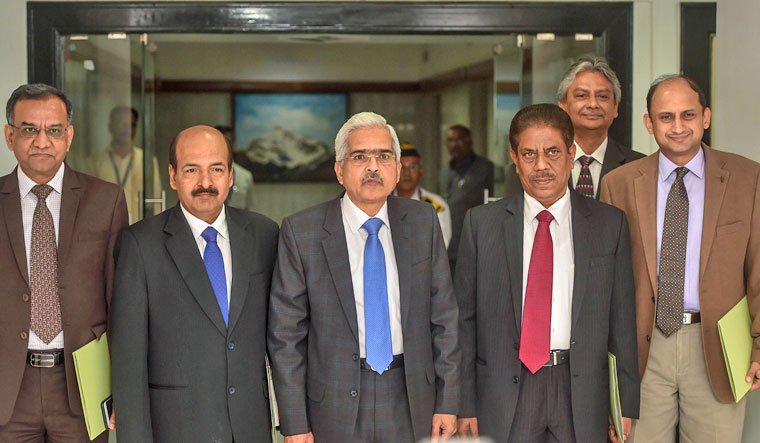Your interest rates are set to come down as the Reserve Bank of India has on expected lines reduced its benchmark repo rate by 0.25 per cent (25 basis points) to 6 per cent, as Governor Shaktikanta Das looks to give a boost to the slowing economy, while inflation remains low. This is the second time that the central bank has reduced interest rates this year, following a similar 0.25 per cent repo rate cut in February.
India’s GDP growth slowed to 6.6 per cent in the October-December 2018 quarter, versus 7.1 per cent in the second quarter. Global ratings agency Fitch recently reduced its forecast on India’s economic growth to 6.8 per cent from its previous estimate of 7 per cent for the financial year beginning April 1, 2019.
The Asian Development Bank too has cut its India GDP growth forecast to 7.2 per cent from 7.6 per cent.
The RBI itself has reduced its GDP growth forecast for 2019-2020 to 7.2 per cent from 7.4 per cent. It also reduced retail inflation expectation downwards to 2.4 per cent from 2.8 per cent for the quarter-ended March 31, 2.9 per cent to 3.0 per cent in the first half of 2019-2020 (3.2-3.4 expected earlier) and 3.5 per cent to 3.8 per cent in the second half of the year.
“Against this backdrop, the MPC (monetary policy committee) voted to reduce the policy rate by 25 basis points, while maintaining a neutral stance. Going forward, Reserve Bank will continue to watch the evolving macro economic situation and shall act in time and act decisively. With the inflation outlook remaining benign, the RBI will address the challenges to sustain growth of the Indian economy, while ensuring price stability on an enduring basis,” Das told reporters.
Despite a cut in repo rate by the central bank, effective transmission of interest rates by banks has been a concern for a long time. After the repo rate was reduced by 0.25 per cent in February, banks only reduced their lending rates by 0.05-0.10 per cent. Das is keen on more speedier transmission.
“We are conscious of the fact that there has to be appropriate and effective transmission of rates. After, the last meeting, I had held a meeting with the banks. Banks have marginally up to about 10 basis points cut their MCLR (marginal cost of funds-based lending rate), but more needs to be done,” said Das.
He further pointed out that the RBI had separately taken several steps to infuse liquidity in the system, by way of open market operations and currency swap that was announced recently.
“The RBI had announced a $5 billion Rupee-US Dollar forex swap wherein banks would get rupees in lieu of swapping US Dollars with the RBI for a period of 3 years. This we believe is a masterstroke from a liquidity injection perspective and such continued measures would certainly augur well for the fixed income markets,” said Lakshmi Iyer, CIO (Debt) at Kotak Mahindra Asset Management Company.
In a bid to ensure timely transmission of interest rates, the central bank had in December 2018 proposed that all new floating rate personal or retail loans, like home loans and auto loans, as well as floating rate loans to micro and small enterprises, be benchmarked to external benchmarks like the RBI repo rate.
On Thursday, the RBI said that based on feedback from stakeholders on various issues, it has been decided to hold further consultations and work out an effective mechanism for transmission of rates.
“With the output gap remaining negative and domestic economy facing headwinds from global sluggishness, the rate cut was timely and coming as it does on back to back sittings, it should augur well for coming quarters... Rate cuts are more effective when liquidity is positive, therefore, the operating theme could be to move to a durable positive liquidity, which by itself mark a step towards a more accomodative stance,” said R.K. gurumurthy, head, treasury, Lakshmi Vilas Bank.
Sujan Hajra, chief economist at Anand Rathi Shares and Stock Brokers, feels if the RBI’s forecasts on inflation and growth pan out, there could be a further 0.25 per cent to 0.50 per cent repo rate cut in 2019.
Others like Mahesh Singhi, MD of Singhi Advisors too sees more scope for rate cuts ahead, given that retail inflation is much lower than the RBI’s target.
“The MPC’s decision to slash repo rate signals a benign rate regime going forward. With headline inflation remaining well below the RBI’s target, there is still much more room for the RBI to cut rate,” said Singhi.
Private weather forecaster, Skymet, has forecast below normal monsoon rain this year. Some analysts say there are risks of rising food inflation ahead, which the central bank may have underestimated.
“Food inflation is likely to turn positive in March 2019, after five consecutive months of negative print. Given the high weightage of food in the CPI (consumer price index) basket, rising food prices are likely to push headline inflation to 2.89 per cent in March 2019, taking the Q4 average to 2.6 per cent, which is 20 basis points higher than MPC’s estimate,” said Anagha Deodhar, economist, ICICI Securities.
Deodhar also believes that retail inflation in the first half of 2019-20 and the second half could be 0.30 per cent to 0.50 per cent higher than the MPC trajectory.



